Indian Bushlark and Singing Bushlark are very similar species that share many morphological features. Identification can be a real challenge. Luckily, one feature has often served as a shortcut out of this identification conundrum – the presence of white on the outermost tail feathers. Any Indian/Singing Bushlark with ‘white’ in its outermost tail feathers has always been readily identified as a Singing Bushlark. This is because our five main national ornithological references (Table 1) do not indicate the possibility that Indian Bushlark can have white in the tail.
| Authors | Reference | Published |
| Salim Ali and Dillon Ripley | Handbook of the Birds of India and Pakistan: Together with Those of Nepal, Sikkim, Bhutan and Ceylon | 1987 |
| Richard Grimmett, Carol Inskipp and Tim Inskipp | Birds of the Indian Subcontinent | 1998 |
| Krys Kazmierczak | A Field Guide to the Birds of the Indian Subcontinent | 2000 |
| Richard Grimmett, Carol Inskipp and Tim Inskipp | Birds of the Indian Subcontinent | 2011 |
| Pamela Rasmussen and John Anderton | Birds of South Asia: The Ripley Guide | 2012 |
Table 1: The five main bird guides in India
Our ornithological literature, however, also indicates that Singing Bushlark has almost fully white outermost tail feathers. What then are the bushlarks found around the country that do not have fully white outermost tail feathers but have white restricted to the outer webs? Such birds have been historically identified as Singing Bushlark but have we been correct?
It appears that we have been missing some information all along! Indian Bushlarks can indeed have white outer webs to their outermost tail feathers, but this feature has surprisingly been overlooked in our literature. Or in other words, white on the tail is not diagnostic. How then do we separate Indian Bushlark and Singing Bushlark? In this article, I will take you through the identification of these two species using a series of comparative images.
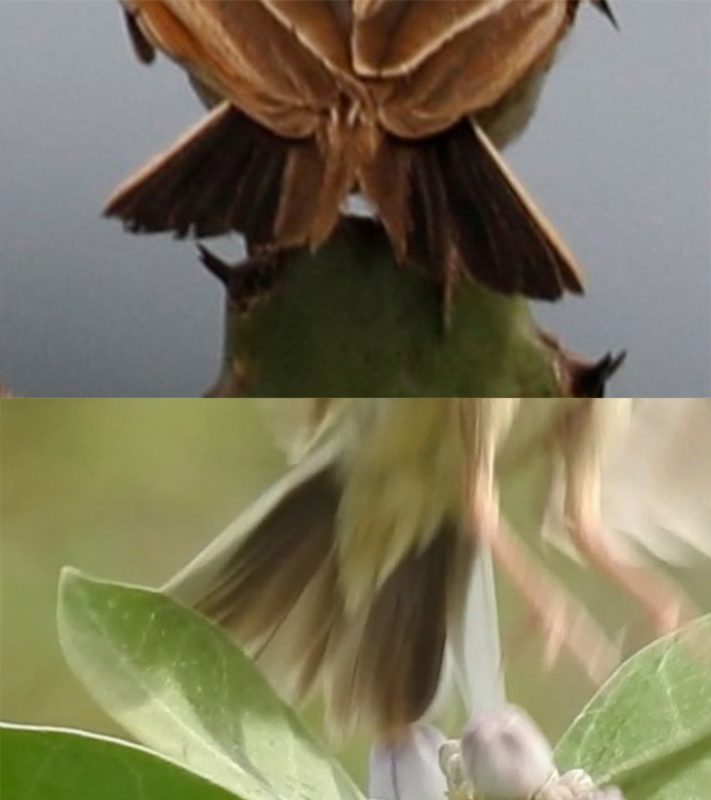
Indian Bushlark (upper panel) – white is restricted to the outer web of the outermost tail feathers
Singing Bushlark (lower panel) – the outermost tail feathers are almost entirely white with only a dark edge to the inner web of the outermost tail feathers
(photos: Vijaya Lakshmi and Ashwin Viswanathan)
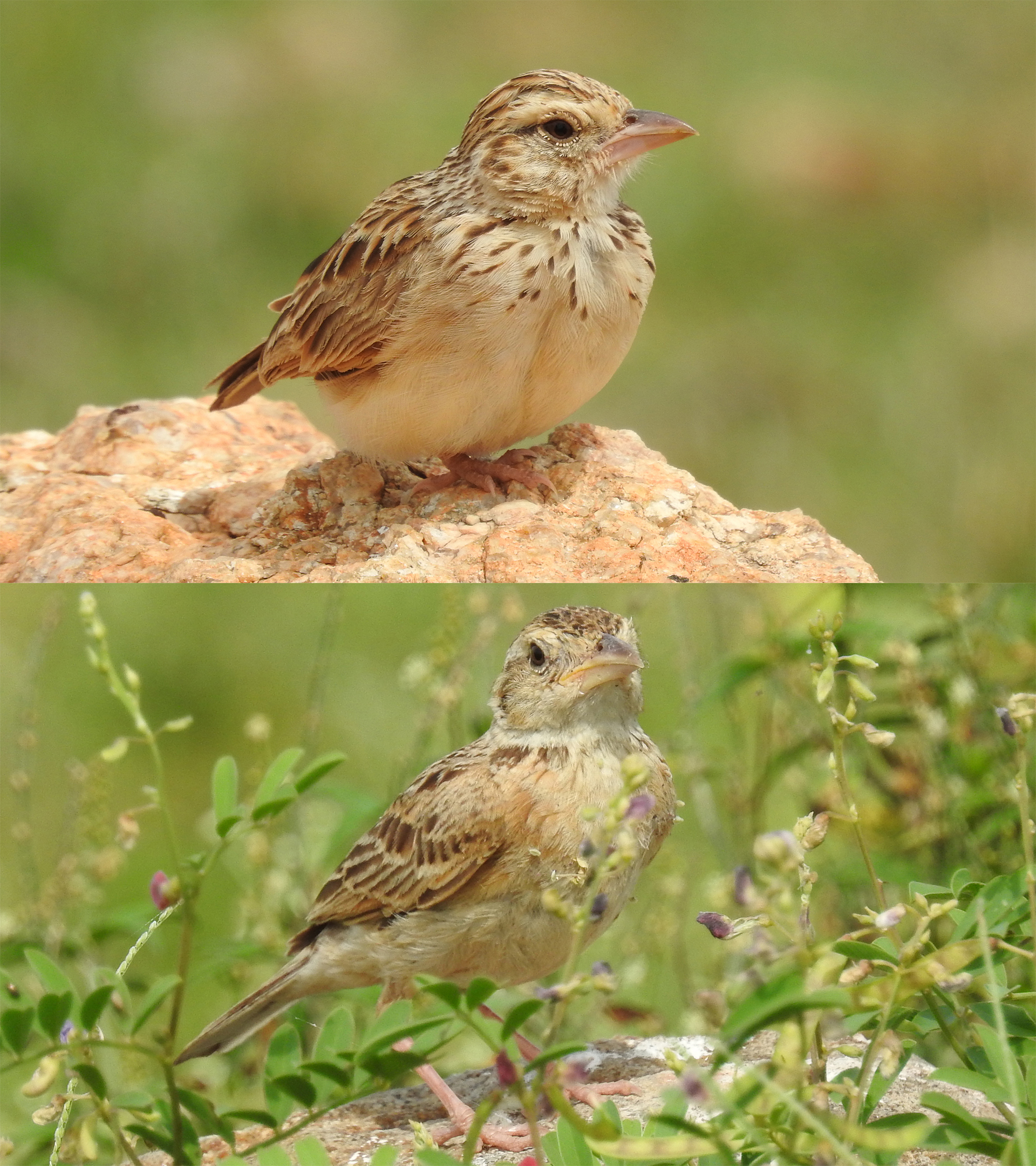
Indian Bushlark (upper panel) – prominent spotting on the breast, lack of a fleshy gape
Singing Bushlark (lower panel) – almost a fully unmarked breast, sometimes with faint streaking, fleshy (yellowish) gape
(photos: Ashwin Viswanathan)
Singing Bushlark often has a contrasting white throat, inconspicuous to no streaking on the breast, the appearance of a brown breast band, and near-unmarked ear coverts. Singing Bushlark also usually (not always) has a shorter bill and prominent fleshy (yellowish) gape even in adults, much like the fleshy gape of a young juvenile bird.
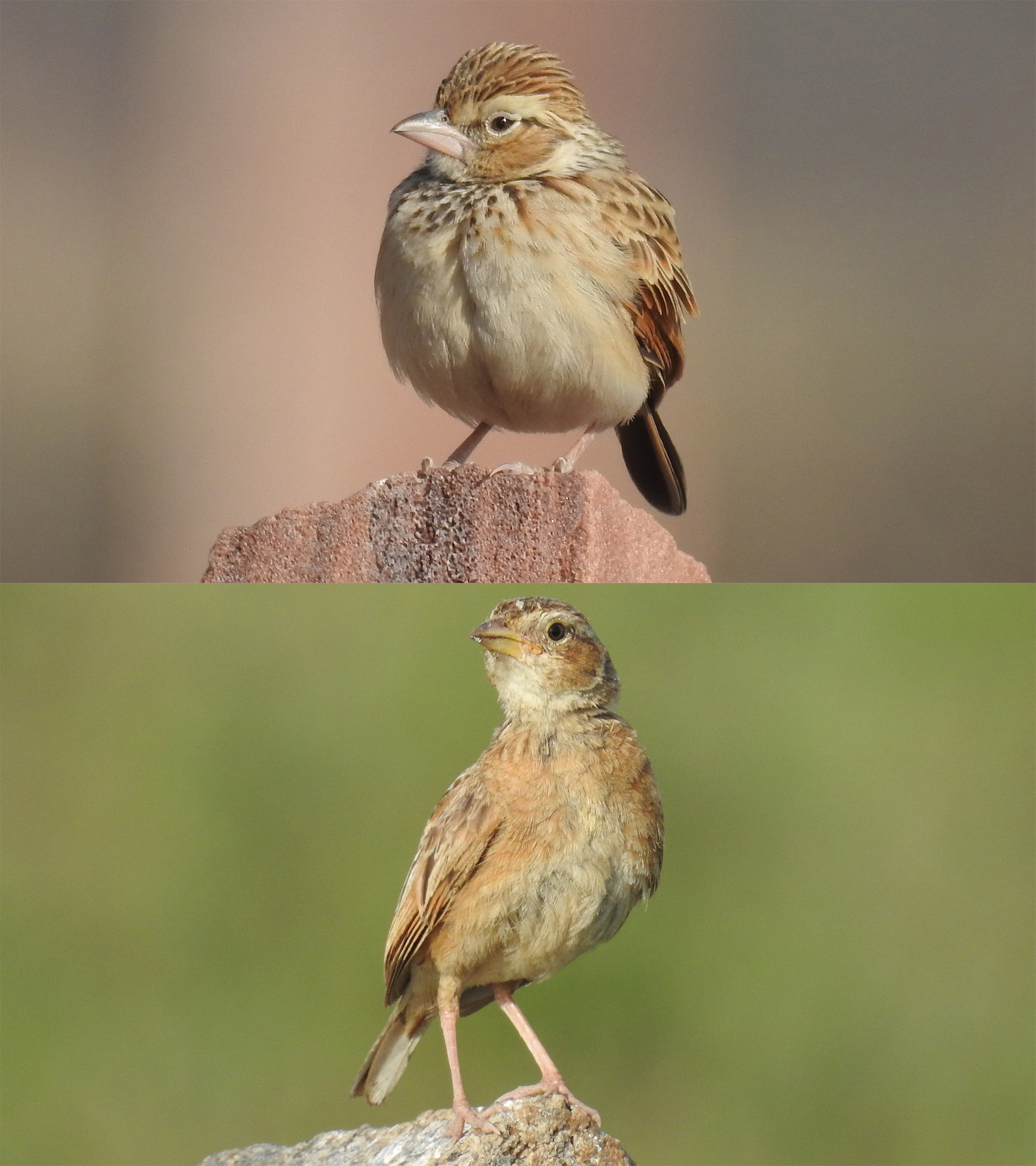
Indian Bushlark (upper panel) – note prominent spotting on the breast and limited contrast in the underparts
Singing Bushlark (lower panel) – complete lack of spotting on the breast, a white throat contrasting with a brown breast band, fleshy gape
(photos: Ashwin Viswanathan)
Indian Bushlark has very prominent rufous on the wings (hence the alternate name Red-winged Bushlark).
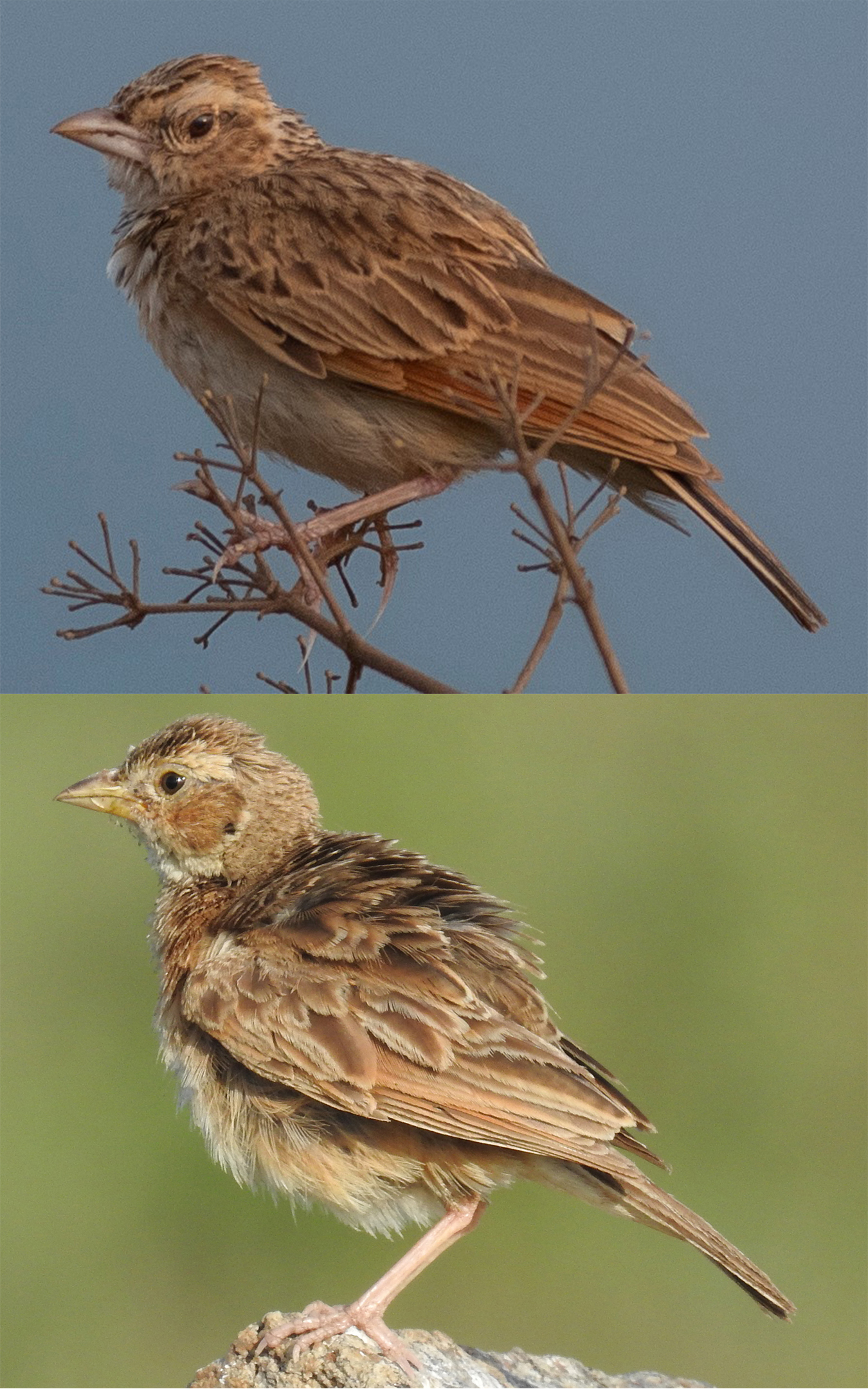
Indian Bushlark (upper panel) – note that this bird has prominent white on the tail but shows prominent spotting on the ear coverts and contrasting rufous on the wings
Singing Bushlark (lower panel) – unmarked ear coverts, less contrasting plumage rufous on the wings, fleshy gape
(photos: Vaidehi Gunjal and Ashwin Viswanathan)
Indian Bushlark is usually more heavily streaked on the upperparts (mantle, nape and crown) than Singing Bushlark. The upperparts of Indian Bushlark are usually tinged with rufous (particularly in the crown) unlike the greyish-brown upperparts of Singing Bushlark.
Indian Bushlark often cocks its tail up, a behaviour that is far less common in Singing Bushlark.
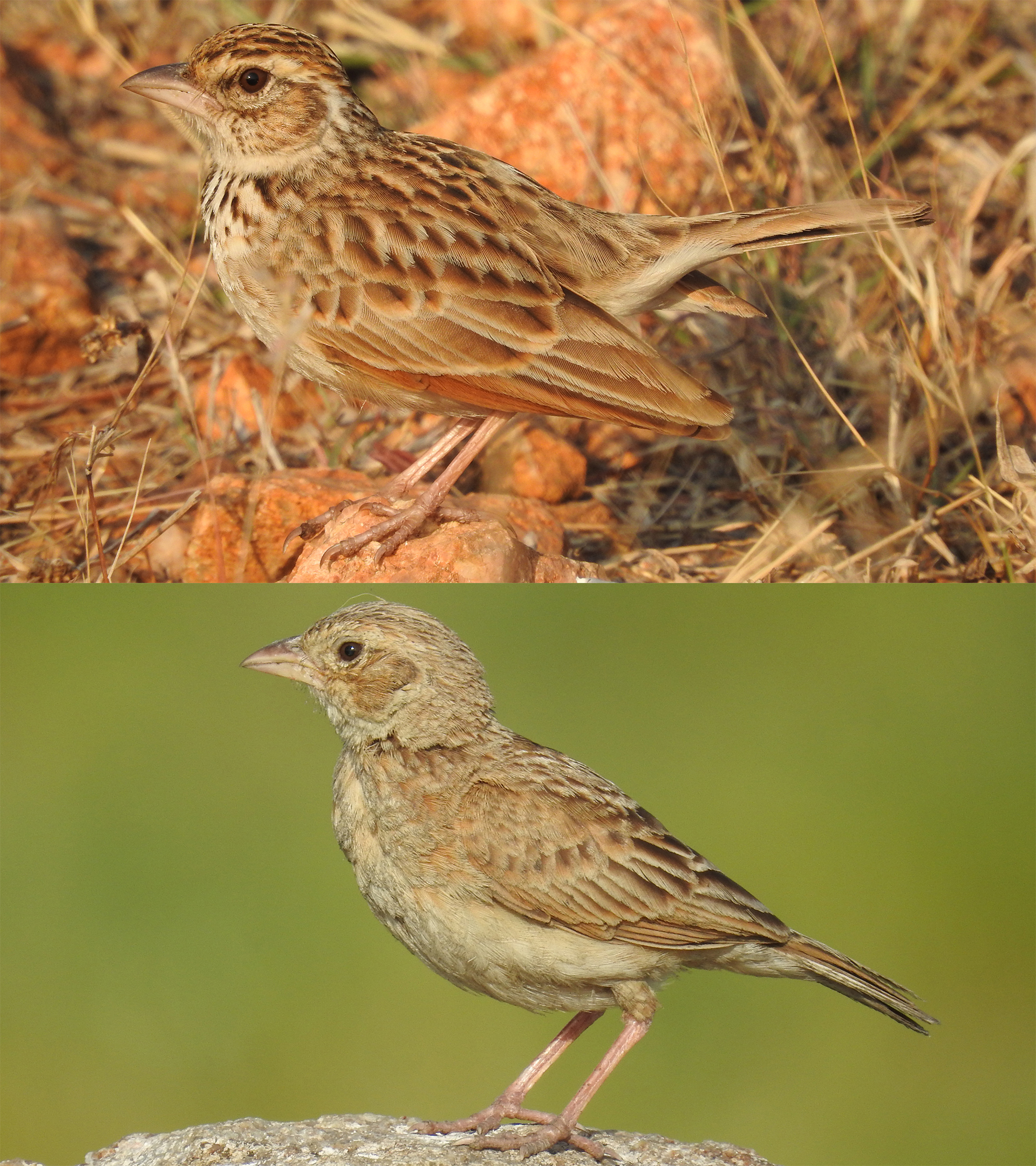
Indian Bushlark (upper panel) – prominent spotting on the breast, prominent spotting on the ear coverts, heavily streaked upperparts with a rufous cast, contrasting rufous on the wings, tail cocked up which is a characteristic behaviour
Singing Bushlark (lower panel) – plain, unspotted breast and ear coverts, limited contrast between the greyish-brown upperparts and rufous on the wings
(photos: Ashwin Viswanathan)

Indian Bushlark (upper panel) – although this bird has prominent white on the tail but restricted to the outer web, note the spotting on breast, lack of contrast in the underparts, rufous cast to the upperparts and spotting on the ear coverts
Singing Bushlark (lower panel) – note that the outermost tail feathers are almost entirely white with only a dark edge to the inner web, indistinctive fine streaking on breast, contrasting white throat and brown breast band, greyish-brown upperparts and relatively uniform ear coverts, fleshy gape
(photos: Sahana M and Sakthi Chinnakannu)
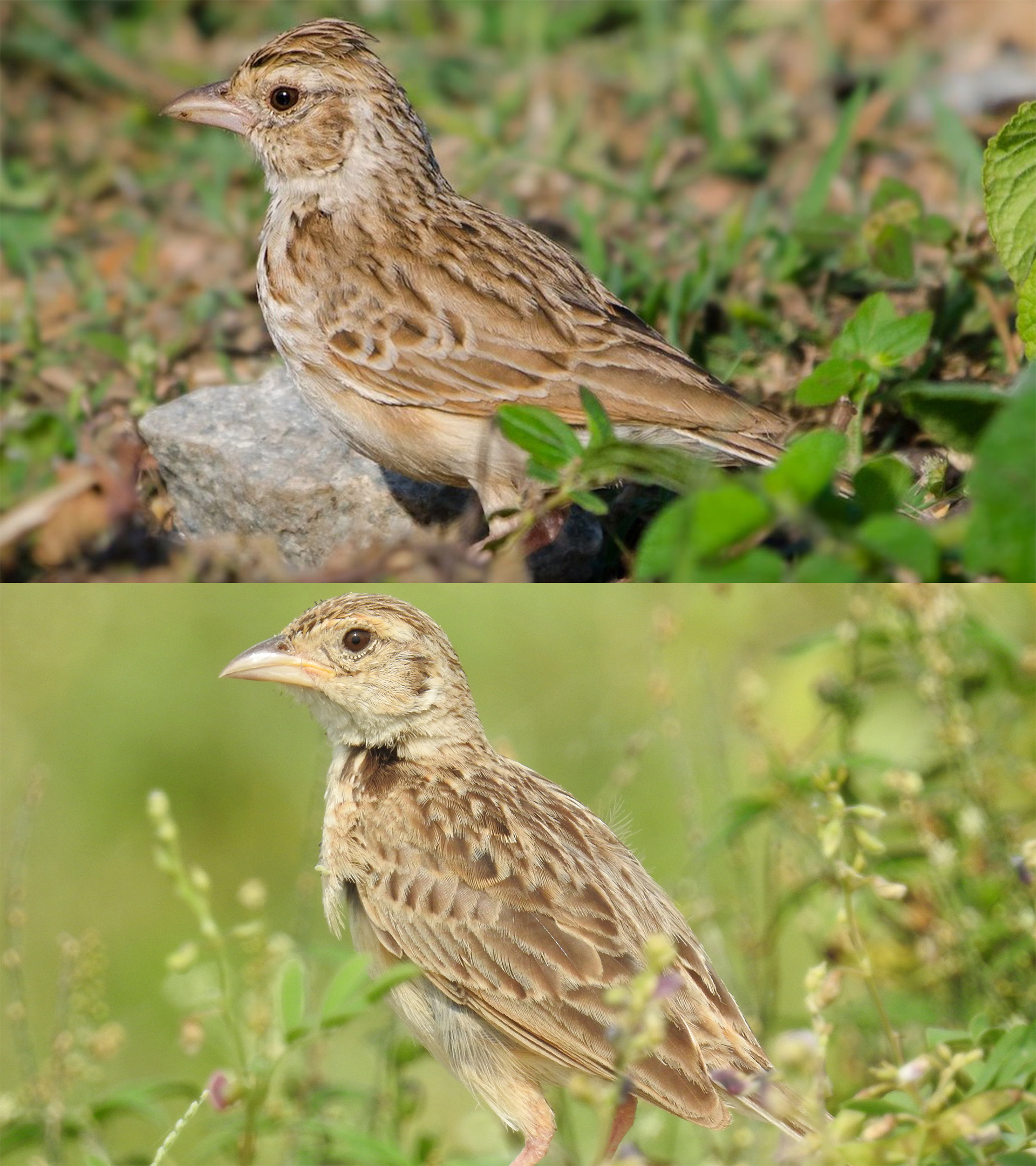
Indian Bushlark (upper panel) – shows prominent white on the tail but heavily streaked, contrasting upperparts and distinctly spotted ear coverts
Singing Bushlark (lower panel) – less streaking on the upperparts, fully plain ear coverts, fleshy gape
(photos: Abhiram Shankar and Ashwin Viswanathan)
Unlike Indian Bushlark, Singing Bushlark can look very top heavy while singing with the white throat looking puffed out and conspicuous. Singing Bushlark can also appear very long-legged.
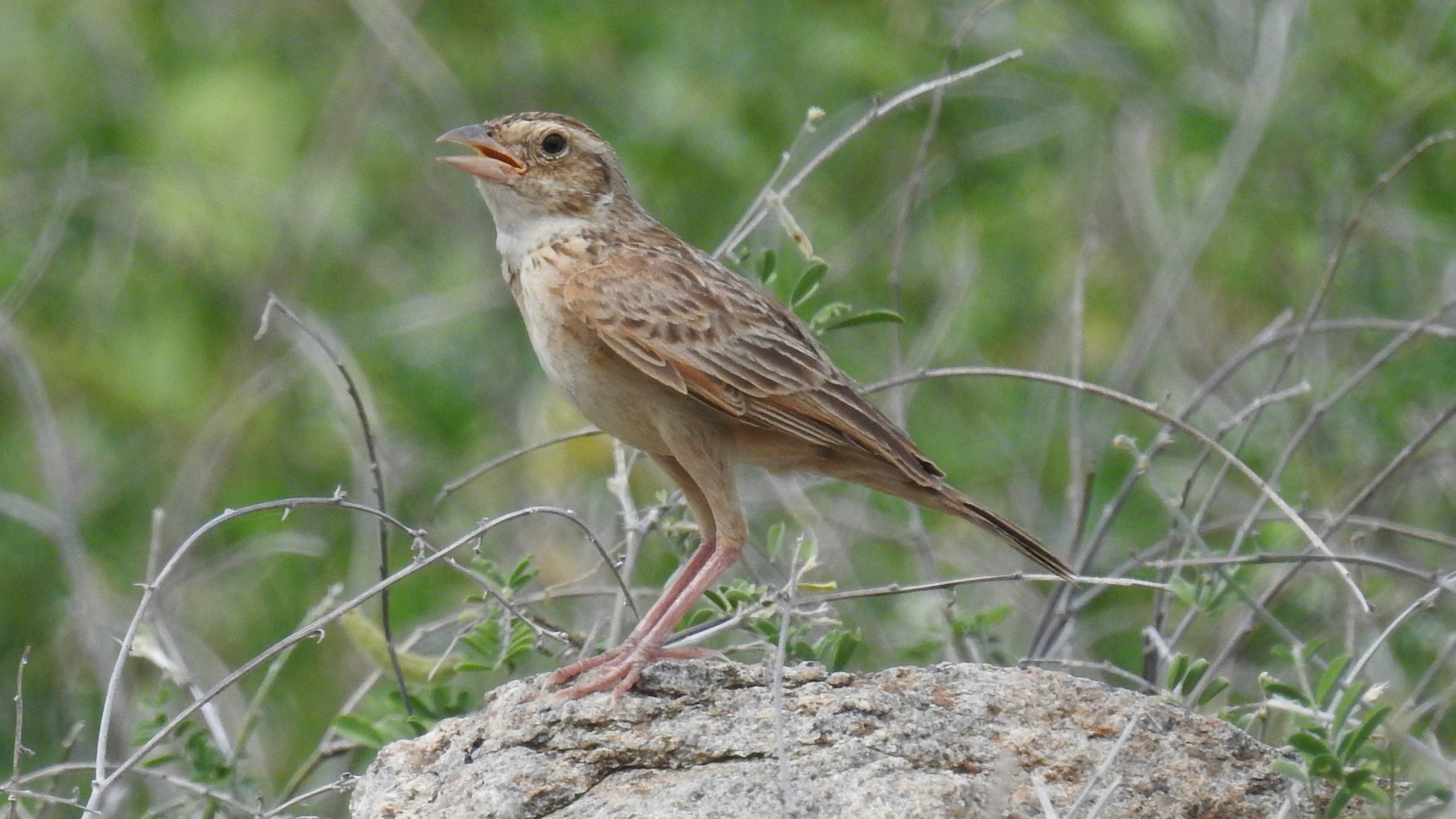
Singing Bushlark: puffed up white throat and top heavy appearance, lack of breast streakings, uncontrasting greyish-brown plumage, plain ear coverts and very long-legged appearance!
(photo: Ashwin Viswanathan)
Songs
And finally, Indian Bushlark has a relatively simple song that includes a series of whistles and trills. Singing Bushlark has an incredibly complex song and has been known to perfectly mimic over 30 bird species! It is a true songster. If either of these Bushlarks are singing, identification will be remarkably easy,
The song of Indian Bushlark – sequences are largely repeated and consists of a series of whistles. Indian Bushlark songs can also contain other combinations of whistles and trills (check video).
The song of Singing Bushlark – considerable variation, mimicry and very few repeated sequences. What other bird calls has it mimicked both in the audio recording and the embedded videos? Do post your thoughts and replies in the comments.
The videos also illustrate several of the characters discussed previously in this article.
Fun fact: Singing Bushlarks in Africa have not been known to include mimicry in their songs!
Habitat and behaviour
Singing Bushlark mainly occurs in short, dense vegetation, a unique habitat type that is mostly provided within its distribution by agriculture like millets, groundnut, and other similar short crops! Unlike Indian Bushlark, it rarely occurs in short/natural grassland or stony flats where Indian Courser and similar grassland specialists are found.
Behaviourally, Singing Bushlark is completely different from the other Mirafra bushlarks within its range. When not singing for long periods way up in the sky (a display behaviour not shown by Jerdon’s and Indian Bushlark that only shoot up into the sky singing for small periods before coming back down) or from an open perch, it tends to hide in vegetation and can be very shy! When flushed, it tends to fly some distance away, hover above the vegetation for a bit, before settling out of sight again. This behaviour is similar to Richard’s Pipit that rarely sits out in the open and usually settles out of sight in grass clumps.
Variation in plumage of Singing Bushlark
I have described and discussed features that Singing Bushlark typically shows during the breeding season when it is most visible. In non-breeding and immature plumages, it can have some spotting on the ear coverts and prominent spotting/streaking on the breast. Such birds (below), however, can be identified as they behave differently from Indian Bushlark and appear darker and greyer with a less contrasting wing panel.
Conclusion
Both Indian Bushlark and Singing Bushlark can have white on the outermost tail feathers but Indian Bushlark has white restricted to the outer webs whereas these feathers are almost fully white in Singing Bushlark. In field, tail feathers are however rarely visible. Indian Bushlark can be separated from Singing Bushlark using a combination of a number of features: 1) prominent spotting on breast 2) spotting on ear coverts 3) lack of a contrasting white throat and brown breast band 4) contrasting upperparts with heavy streaking 5) contrasting and prominent rufous wings 6) pale upperparts with a rufous cast unlike the greyish-brown upperparts of Singing 7) behaviour of regular tail cocking 8) song 9) shy behaviour of hovering over vegetation and settling out of sight when not actively singing!
While Indian Bushlark is distributed throughout the dry parts of the Indian peninsula, Singing Bushlark is associated with dry regions but is very ‘local’ and not known from many localities around the country. Indian Bushlark is resident whereas the movements of Singing Bushlark are still poorly understood with very few records during winter. Where are the Singing Bushlarks during winter? Why are they so patchily distributed? So many mysteries still to unravel about these enigmatic species.
Happy mystery solving and bushlark watching!

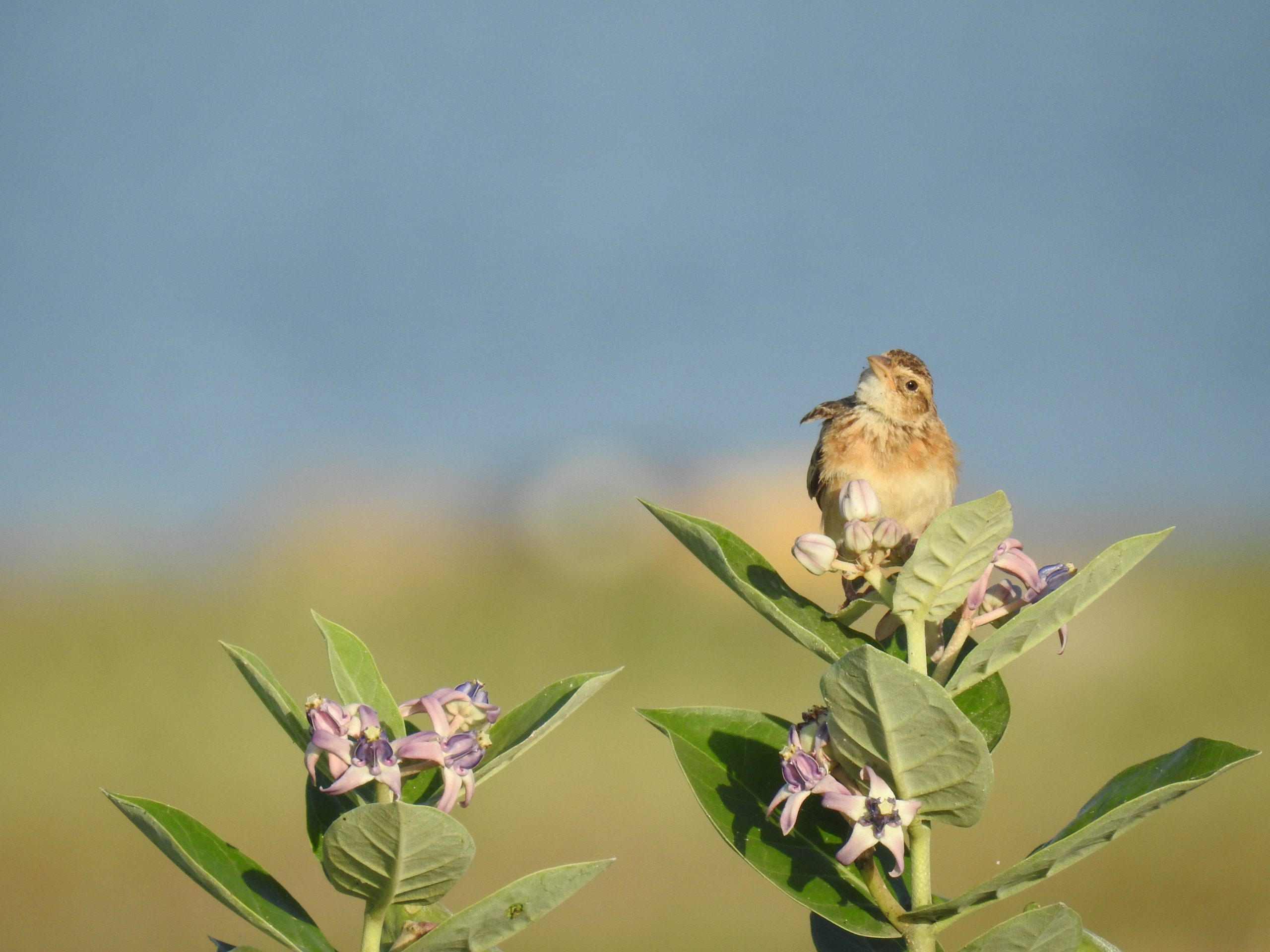
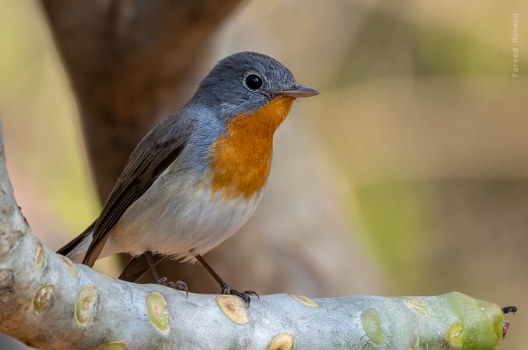
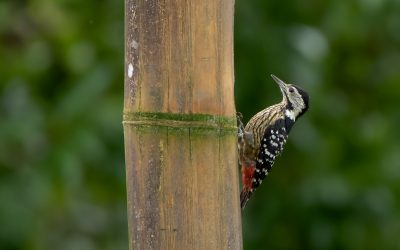
Thank you for such wonderful insight of these equally wonderful birds. while I was at Gurgaon(Hariyana) during my job in years 2007 to 2010, I saw few bushlarks in sector 54-55 patch (it was a hilly patch then, no more exist due to severe construction activities, but I still remember the birds, those sparrow sized birds would fly high from bush, flatten their wings, singing in air and come back on bush, I still remember that they used to have rufous on wing. 3-4 birds would fly and sing one after other in small patch of wild bushes and make the environment literally romantic. I confirmed them as red winged bushlark (Mirafra erythroptera) based on the rufous wing patch when perched on a bush as confirmed from Salim Ali’s The Book of Indian Birds. Today from your article I understood that this particular bird was Indian bushlark. thank you for sharing such wonderful insight.
That’s wonderful to hear. Thank you for the comment.
Thank you for such lucidly explained account of ID features. Great help n learning.
Thank you!
Yes this is confusing about larks however, these are not solitary birds their specific type of flight and wing closing along with voice note is also important the tail white can not be generalized
Hello Ashwin,
A much needed and lovely article.
Singing Buslark is of my special interest and have been trying to understand the species since some years now. Luckily I get good opportunity to see both these species on field during my birding tours. The Singing Bushlark is abundant in certain places (like Shokhaliya, Ajmer where I take tours for Lesser Florican) and scarce in many other places like Tal Chappar, Central India, scrublands of Maharashtra etc….. In all the places both (Singing & Indian) Bushlark species occur together and hence I get good practice to compare the two.
I would like to add a couple of features regarding identification among both these species that I find helpful.
1) Singing Bushlarks almost always (with exception) show a sight fleshy (pale yellow) gape and the beak is comparatively smaller
2) The display (during breeding) is completely different.
As far as winter distribution of Singing Bushlarks…… I feel, it being super shy (this is the shy-est) among lark species found in India, and being completely silent during winters, this species is not reported (it rarely comes in open and keeps to grass)…..it is however present and occasionally seen during winters.
Thank you very much Adesh for the kind words and for sharing your knowledge. I have added notes about the presence of a yellowish (fleshy) gape and difference in display flight in the article. I agree that this is by far the shyest lark we have, such a skulker 🙂
Wonderful writing, clearly stating the pointers to identify these two different type of birds